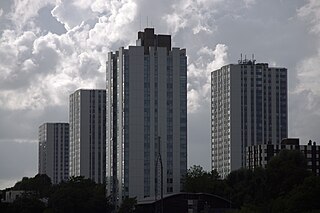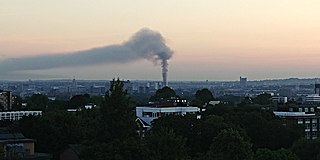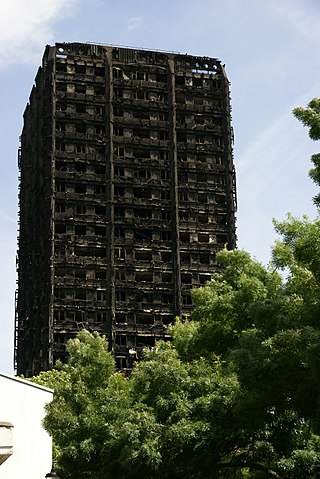
Huyton is a town in the Metropolitan Borough of Knowsley, Merseyside, England. Part of the Liverpool Built-up Area, it borders the Liverpool suburbs of Dovecot, Knotty Ash and Netherley.

The Summerland disaster occurred when a fire spread through the Summerland leisure centre in Douglas on the Isle of Man on the night of 2 August 1973. 50 people were killed and 80 seriously injured. The scale of the fire has been compared to those seen during the Blitz.

Knowsley Council, or Knowsley Metropolitan Borough Council, is the local authority of the Metropolitan Borough of Knowsley in Merseyside, England. It is a metropolitan borough council and provides the majority of local government services in the borough. The council has been a member of the Liverpool City Region Combined Authority since 2014.
Court Hey Park is a park in the Bowring Park suburb of Knowsley borough in Merseyside, England. It lies about 4+1⁄2 miles (7 km) east of Liverpool city centre.

St Chad's Church is in Old Hall Lane, Kirkby, Knowsley, Merseyside, England. It is an active Anglican parish church in the deanery of Huyton, the archdeaconry of Liverpool, and the diocese of Liverpool. Its benefice is united with those of St Mark, Kirkby: St Martin, Southdene, Kirkby: and Tower Hill, St Andrew, Kirkby. The church is recorded in the National Heritage List for England as a designated Grade II* listed building.

Cladding is the application of one material over another to provide a skin or layer. In construction, cladding is used to provide a degree of thermal insulation and weather resistance, and to improve the appearance of buildings. Cladding can be made of any of a wide range of materials including wood, metal, brick, vinyl, and composite materials that can include aluminium, wood, blends of cement and recycled polystyrene, wheat/rice straw fibres. Rainscreen cladding is a form of weather cladding designed to protect against the elements, but also offers thermal insulation. The cladding does not itself need to be waterproof, merely a control element: it may serve only to direct water or wind safely away in order to control run-off and prevent its infiltration into the building structure. Cladding may also be a control element for noise, either entering or escaping. Cladding can become a fire risk by design or material.

Dame Judith Elizabeth Hackitt,, FIChemE, FCGI is a British engineer and civil servant. A former chair of the UK Health and Safety Executive, she is currently chair of manufacturing trade body EEF.
Emma Dent Coad is a British architectural historian and politician who served as Member of Parliament (MP) for Kensington from 2017 to 2019. A former member of the Labour Party, she has been a member of Kensington and Chelsea London Borough Council since 2006. She resigned her Labour membership on 27 April 2023, but remains on the local council as an independent.

On 14 June 2017, a high-rise fire broke out in the 24-storey Grenfell Tower block of flats in North Kensington, West London, England, at 00:54 BST and burned for 60 hours. Seventy people died at the scene and two people died later in hospital, with more than 70 injured and 223 escaping. It was the deadliest structural fire in the United Kingdom since the 1988 Piper Alpha oil-platform disaster and the worst UK residential fire since the Blitz of World War II.

Grenfell Tower is a derelict 24-storey residential tower block in North Kensington in London, England. The tower was completed in 1974 as part of the first phase of the Lancaster West Estate. Most of the tower was destroyed in a severe fire on 14 June 2017.

Tower blocks are high-rise buildings for residential use. These blocks began to be built in Great Britain after the Second World War. The first residential tower block, "The Lawn", was constructed in Harlow, Essex, in 1951; it is now a Grade II listed building. In many cases, tower blocks were seen as a "quick-fix" to cure problems caused by the existence of crumbling and unsanitary 19th-century dwellings or to replace buildings destroyed by German aerial bombing. It was argued that towers surrounded by public open space could provide for the same population density as the terraced housing and small private gardens they replaced, offering larger rooms and improved views, whilst being cheaper to build.

The Harrow Court fire occurred in a tower block on 2 February 2005 in Stevenage, Hertfordshire, England. Three people were killed, two of them firefighters, when a fire developed and spread from the 14th floor. An investigation of the fire found that there was an Abnormal Rapid Fire Development, caused by a candle melting the surface of a television, which then spread rapidly up the outside of the building to subsequent floors.

Chalcots Estate is a council housing estate on Adelaide Road and Fellows Road in Swiss Cottage in the London Borough of Camden. It was designed by Dennis Lennon and Partners. The Chalcots Estate was built on land owned by Eton College, which is reflected in the names of the individual buildings.
Harley Facades is a British construction company that designs and installs external cladding on buildings. Founded in 1996, it established a specialist cladding division in 2002. In 2015, it was contracted to install cladding on Grenfell Tower in west London. After a June 2017 fire killed 72 people in the tower, the Grenfell Tower Inquiry said Harley bore "a significant degree of responsibility for the fire".

The Grenfell Tower Inquiry is a British public inquiry into the Grenfell Tower fire, which killed 72 people and destroyed Grenfell Tower on 14 June 2017. It was ordered by Prime Minister Theresa May on the day following the fire.

On 14 June 2017, the Grenfell Tower fire broke out in the 24-storey Grenfell Tower block of flats in North Kensington, West London, at 00:54 BST; it caused 72 deaths, including those of two victims who later died in hospital. More than 70 others were injured and 223 people escaped. It was the deadliest structural fire in the United Kingdom since the 1988 Piper Alpha disaster and the worst UK residential fire since the Second World War.

The United Kingdom cladding crisis, also known as the cladding scandal, is an ongoing social crisis that followed the Grenfell Tower fire of 14 June 2017 and the Bolton Cube fire of 15 November 2019. The fires revealed that large numbers of buildings had been clad in dangerously combustible materials, comprising a combination of flammable cladding and/or flammable insulation.
The Grenfell Tower Inquiry is a British public inquiry into the Grenfell Tower fire, which killed 72 people and destroyed Grenfell Tower, residential building in the Royal Borough of Kensington and Chelsea, London, on 14 June 2017. It was ordered by Prime Minister Theresa May on the day following the fire.

Criticism of the response to the Grenfell Tower fire primarily consisted of condemnation of issues with the emergency response and fire safety regulation practices in the UK at the time. Broader political criticism was also directed at British society, including condemnation of the response by governmental bodies and UK politicians, social divisions, deregulation issues, and poor transparency overall.














